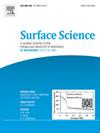Interfacial effect on the formation and properties of stable glasses
IF 1.8
4区 化学
Q3 CHEMISTRY, PHYSICAL
引用次数: 0
Abstract
An in-depth understanding of the relationship between the structure and properties of physical vapor deposited (PVD) glass films is crucial for their applications at the nanoscale within industrial contexts. This study employs a coarse-grained simulation methodology to model PVD films composed of N,N-bis(3-methylphenyl)-N,N'-diphenylbenzidine (TPD) molecules with varying thicknesses. The findings indicate that, in contrast to liquid-quenched glasses (LQG), PVD glasses exhibit a higher elastic modulus and a lower loss modulus in the bulk, corroborating previous research that highlights enhanced mechanical stability. This work also shows that a region adjacent to the substrate of the PVD films has an exceptionally elevated elastic modulus that is correlated with changes in loss modulus, molecular orientation, and out-of-plane mobility. This phenomenon may be attributed to the surface-substrate effect resulting from the PVD process, and this effect may facilitate incoming molecule to a deeper energy state, resulting in a remarkable thermal and mechanical stability of ultrathin films.

界面效应对稳定玻璃形成和性能的影响
深入了解物理气相沉积(PVD)玻璃薄膜的结构和性能之间的关系对于其在纳米级工业环境中的应用至关重要。本研究采用粗粒度模拟方法模拟由不同厚度的N,N-二(3-甲基苯基)-N,N'-二苯基联苯胺(TPD)分子组成的PVD膜。研究结果表明,与液体淬火玻璃(LQG)相比,PVD玻璃具有更高的弹性模量和更低的整体损耗模量,证实了先前的研究强调了机械稳定性的增强。这项工作还表明,PVD薄膜衬底附近的区域具有异常高的弹性模量,这与损耗模量、分子取向和面外迁移率的变化有关。这种现象可能归因于PVD过程产生的表面-衬底效应,这种效应可能使进入的分子进入更深的能态,从而导致超薄膜具有显着的热稳定性和机械稳定性。
本文章由计算机程序翻译,如有差异,请以英文原文为准。
求助全文
约1分钟内获得全文
求助全文
来源期刊

Surface Science
化学-物理:凝聚态物理
CiteScore
3.30
自引率
5.30%
发文量
137
审稿时长
25 days
期刊介绍:
Surface Science is devoted to elucidating the fundamental aspects of chemistry and physics occurring at a wide range of surfaces and interfaces and to disseminating this knowledge fast. The journal welcomes a broad spectrum of topics, including but not limited to:
• model systems (e.g. in Ultra High Vacuum) under well-controlled reactive conditions
• nanoscale science and engineering, including manipulation of matter at the atomic/molecular scale and assembly phenomena
• reactivity of surfaces as related to various applied areas including heterogeneous catalysis, chemistry at electrified interfaces, and semiconductors functionalization
• phenomena at interfaces relevant to energy storage and conversion, and fuels production and utilization
• surface reactivity for environmental protection and pollution remediation
• interactions at surfaces of soft matter, including polymers and biomaterials.
Both experimental and theoretical work, including modeling, is within the scope of the journal. Work published in Surface Science reaches a wide readership, from chemistry and physics to biology and materials science and engineering, providing an excellent forum for cross-fertilization of ideas and broad dissemination of scientific discoveries.
 求助内容:
求助内容: 应助结果提醒方式:
应助结果提醒方式:


